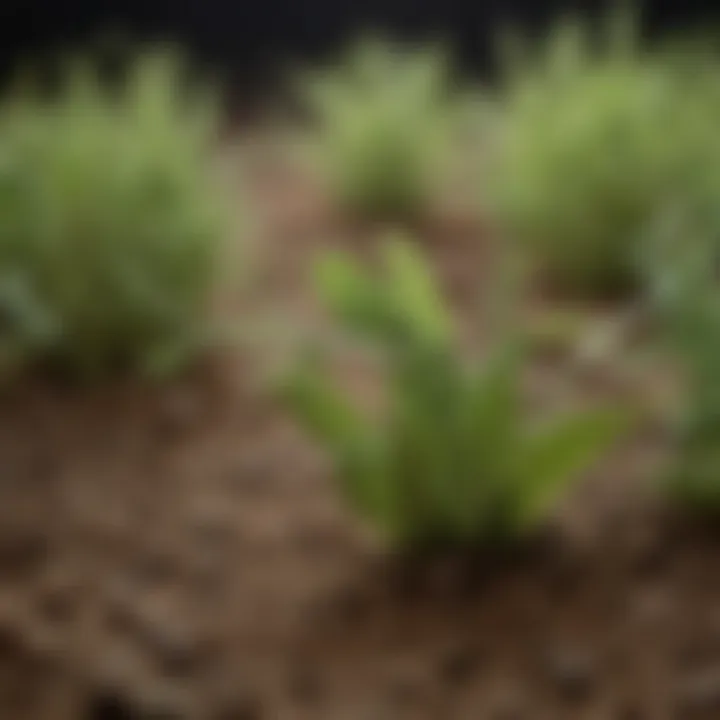The Importance of Legume Seed Inoculants in Farming


Intro
Legume seed inoculants are often overlooked in discussions about agricultural advancements, but they play a significant role in ensuring crop productivity and sustainability. These inoculants, mainly composed of beneficial bacteria known as rhizobia, create a mutually beneficial relationship with leguminous crops, enhancing nitrogen fixation, promoting plant health, and improving soil quality. The impact of these practices has far-reaching implications, not just for the individual farmer but also for the ecosystem as a whole.
As modern agriculture faces challenges such as climate change, soil degradation, and food security, understanding the intricate dynamics of legume seed inoculants becomes increasingly relevant. Exploring the composition, benefits, application techniques, and innovative solutions surrounding these inoculants can equip researchers, educators, and practitioners with the knowledge needed to optimize agricultural practices effectively.
In this article, we will dissect the essential components of legume seed inoculants, delve into their operational mechanics, and assess their significance in today’s agricultural landscape. Ultimately, we aim to facilitate a deeper understanding of how these biological tools can lead to improved farming practices and sustainable food production.
Key Concepts and Terminology
Definition of Key Terms
To thoroughly grasp the significance of legume seed inoculants, it is crucial to define some key terminologies:
- Inoculant: A substance containing live microorganisms, specifically tailored to enhance plant growth through symbiotic relationships.
- Rhizobia: A group of soil bacteria that colonize the roots of legumes and enable the fixation of atmospheric nitrogen.
- Nitrogen fixation: The process by which nitrogen in the atmosphere is converted into ammonia or related compounds, making it accessible for plant uptake.
Concepts Explored in the Article
This article will cover various concepts, including:
- The biological relationship between legumes and rhizobia that fosters nitrogen fixation.
- The various types of inoculants available and their specific roles in maximizing agricultural efficiency.
- Practical application methods used by farmers to ensure effective implantation of inoculants at planting time.
By unpacking these elements, we aim to provide a structured understanding of how legume seed inoculants can transform agricultural operations.
Findings and Discussion
Main Findings
Legume seed inoculants provide a plethora of benefits that can significantly influence agricultural productivity. Main findings from recent studies include:
- Enhanced Nitrogen Levels: Utilization of inoculants can increase the nitrogen content within the soil, which is essential for plant growth. This contributes to healthier crops and higher yields.
- Improved Soil Health: Inoculating legume seeds can lead to better soil structure and microbial diversity, fostering a healthier ecosystem.
- Cost-Effectiveness: The use of inoculants has shown a significant reduction in the need for synthetic fertilizers, helping farmers save money and reduce their environmental footprint.
Potential Areas for Future Research
As much as we know today, there are still plenty of areas in this field ripe for exploration, such as:
- Development of more advanced inoculant formulations that can cater to diverse soil types and climates.
- Longitudinal studies on the impact of inoculants over multiple planting cycles to better understand their long-term effects.
- Exploration of synergistic effects when combining inoculants with other sustainable practices, such as crop rotation and reduced tillage.
Recognizing and embracing the biology behind legume inoculants is not just a trend; it's a stepping stone toward sustainable agricultural practices.
Arming ourselves with informed strategies regarding legume seed inoculants can create pathways for future advancements in agriculture. The role these products play in enhancing both soil quality and plant health positions them at the forefront of agricultural innovation.
Prolusion to Legume Seed Inoculants
Legume seed inoculants serve a pivotal role in agriculture, particularly in enhancing the productivity of leguminous crops. These crops, which include beans, lentils, and peas, have a unique ability to form symbiotic relationships with specific bacteria known as rhizobia. The purpose of inoculants is to ensure that these beneficial microbes are present in sufficient numbers at the time of seed planting, thereby promoting effective nitrogen fixation and overall plant health. By doing so, inoculants help in the efficient use of soil nutrients and contribute to sustainable farming practices.
Definition and Purpose
Legume seed inoculants can be defined as specialized preparations containing live microorganisms, mainly rhizobia. These preparations are either coated onto the seeds or applied to the soil before planting. The primary purpose of these inoculants is to establish a symbiosis between the legume plants and the rhizobia, which are capable of converting atmospheric nitrogen into a form that the plants can utilize. Through nitrogen fixation, legumes can thrive even in nitrogen-deficient soils, providing essential nutrients that not only benefit the legume plants themselves but also enhance the fertility of the land for subsequent crops.
Moreover, using seed inoculants has other advantages such as:
- Increasing crop yields: Well-nodulated plants generally produce more biomass and seeds.
- Reducing chemical fertilizer usage: Farmers can rely less on synthetic nitrogen fertilizers, leading to cost savings and diminished environmental impact.
- Improving soil structure: The organic matter generated from legume roots enriches the soil, promoting healthier crops in the long run.
Historical Context
The story of legume seed inoculants is closely intertwined with the understanding of soil biology and plant nutrition. The significance of rhizobia wasn’t fully appreciated until the late 19th and early 20th centuries when researchers began to uncover the role of these microorganisms in nitrogen fixation. In the early 1900s, scientists like Hellriegel and Wilfarth conducted significant work demonstrating the relationship between certain bacteria and leguminous plants.
As agriculture evolved, so did the application techniques and formulations of inoculants. Initially, methods were rudimentary, often using soil from where legumes were previously grown. However, innovations in biotechnology and microbiology led to the production of commercial inoculants that are tailored for specific crops and environmental conditions.
This shift has allowed for broader usage across various regions, making inoculants an integral part of modern sustainable agriculture. Today, their role is not just limited to increasing legume yields but also includes contributions to ecosystem health and resilience against changing climate conditions.
The Science Behind Inoculants
In the realm of agriculture, especially when discussing legume cultivation, the understanding of inoculants emerges as a cornerstone of modern practices. These biological substances significantly enhance the symbiotic relationships between legumes and certain microorganisms. Grasping the science behind these inoculants helps stakeholders—be they farmers, agricultural researchers, or policy makers—understand their potential in promoting sustainable farming. This section will delve into the diverse types of inoculants and the pivotal role of rhizobia as the primary microorganism involved.


Types of Inoculants
When it comes to the world of legume inoculants, variety is indeed the spice of life. There are mainly two types of inoculants widely used in agricultural settings: liquid and solid.
- Liquid Inoculants: This type consists of a suspension of live rhizobial cells in a liquid medium. They are often spray-applied directly onto the seeds. Their main advantage lies in the ease of application and the ability to achieve even coverage of the seed surface.
- Solid Inoculants: These come in powdered form and are typically formulated to adhere to seeds. The solid form can also include carriers that protect the microorganisms during storage and application. This type is often seen as more stable in terms of microbial viability, but requires careful handling to ensure that sufficient inoculum is available at planting.
Other modifications, like pelleted or coated seeds, also incorporate these inoculants. Each type possesses its own pros and cons. Whatever the method, choosing the right inoculant type hinges on specific environmental conditions and personal preference.
Rhizobia: The Key Microorganism
As we explore this area, one cannot understate the significance of rhizobia. These nitrogen-fixing bacteria form a critical component of legume seed inoculation.
Role in Nitrogen Fixation
Nitrogen fixation is a phenomena where atmospheric nitrogen is converted into a form usable by plants. In legumes, this process occurs in the root nodules where rhizobia reside.
- The paramount feature of this role is the ability of rhizobia to convert nitrogen gas from the atmosphere into ammonia, which the plants utilize to grow.
- This not only benefits the legumes themselves, enhancing their growth and development, but also enriches the soil, making it fertile and ready for subsequent crops.
- This amalgamation of benefits is what renders nitrogen fixation a highly sought-after trait in agricultural practices.
However, the efficiency of this process depends significantly on environmental conditions, such as soil type and moisture levels. While it holds immense potential, the practical outcomes can be variable.
Interaction with Host Plants
The relationship between rhizobia and legume host plants is a fascinating dance of biology. It is mutualistic; both parties benefit from this partnership.
- One of the pivotal characteristics is that rhizobia stimulate root development in legumes as they coalesce in the root nodules. This interaction not only supports better nutrient uptake but also facilitates water retention by the plant.
- Moreover, this connection is particularly beneficial in stressed environmental conditions, helping plants withstand drought or soil deficiencies.
- However, the success of this interaction isn't guaranteed. If the rhizobia strain isn’t compatible with the particular legume variety, the expected benefits may fall flat, leading to disappointing outcomes in yield and health.
Understanding these dynamics offers crucial insights into optimizing legume production and improving agricultural sustainability. While the use of inoculants and rhizobia is not without its challenges, their strategic application can deliver significant advantages in cultivating healthier crops.
"The dual role of rhizobia in enhancing both plant growth and soil fertility underscores its importance in sustainable agriculture."
By diving deeper into the science of inoculants, it becomes clearer that these microorganisms are not merely helpers; they’re essential players in the larger narrative of agricultural efficiency and productivity.
Benefits of Using Inoculants
Legume seed inoculants play an essential role in contemporary agriculture, particularly for farmers looking to maximize both yield and sustainability in their practices. The application of inoculants significantly enhances plant growth and soil conditions, making them a pivotal element for anyone involved in agro-economics. Understanding the various benefits of these inoculants can aid not just in decision-making but also in the strategic planning of crop production.
Enhanced Nutrient Absorption
One of the standout benefits of using legume seed inoculants is the improved nutrient absorption they provide to plants. Legumes, when properly inoculated with specific strains of rhizobia, form root nodules that house these beneficial bacteria. In return for carbohydrates from the plant, the rhizobia fix atmospheric nitrogen into a form usable by the plant. This relationship means that legumes can thrive even in nitrogen-poor soils, enhancing their nutrient profile. Farmers can observe that crops inoculated with the right rhizobia strain often show increased vigor, more substantial foliage, and ultimately higher yields. This nutrient absorption is not just limited to nitrogen; the enhanced presence of beneficial microorganisms helps in the uptake of other vital nutrients, further boosting plant health.
Soil Health Improvement
Inoculants contribute to better overall soil health as well. The introduction of live microorganisms into the soil can improve its structure and improve its biological diversity. Healthy soil is teeming with life, from microbes to earthworms; it’s often described as the backbone of a sustainable agricultural system. By facilitating the establishment of beneficial bacteria, inoculants can reduce soil compaction, enhance aeration, and even increase moisture retention capacity. This means that farmers not only Notice better performance from their crops but also create a balanced ecosystem that supports varied plant communities over time. With improved soil health, there's less reliance on chemical fertilizers and pesticides, which can have detrimental effects on the environment.
Economic Advantages for Farmers
Incorporating legume seed inoculants can also lead to substantial economic benefits for farmers. While there is an upfront cost associated with purchasing these bacterial inoculants, the long-term savings often outweigh initial investments. For instance, better nutrient absorption leads to lower fertilizer costs. Farmers might find that they can apply less nitrogen fertilizer while enjoying comparable or even greater yields. Moreover, with the improved soil condition and nutrient profile, the overall productivity and resilience of the crop can lead to higher market prices. Properties like better drought resistance from healthy legumes can mean farmers get better returns even during challenging weather conditions. The wisdom in using inoculants not only cultivates better crops but also reflects savvy farming practices, enhancing profitability in competitive markets.
"Investing in legume seed inoculants is like putting money in the bank. The returns are measurable—not just in crop yield but in soil health and economic sustainability."
In summary, the advantages of using legume seed inoculants are multifaceted, positively impacting nutrient absorption, soil health, and farmer economic viability. As agriculture continues to evolve, these benefits highlight the importance of strategic inoculant usage as a cornerstone of modern farm management.
Application Techniques
Application techniques for legume seed inoculants play a vital role in ensuring that the benefits of these microbial agents are fully realized. Proper application can significantly enhance the effectiveness of inoculants and promote greater returns for farmers. By ensuring that the microorganisms in the inoculants are effectively delivered to the seeds and subsequently to the plants, growers can maximize nutrient uptake and optimize crop yields.
Seed Treatment Methods
Each seed treatment method has its own unique strengths and considerations that define its suitability for various agricultural situations.
Coating
Coating is a method where seeds are covered with a thin layer of inoculant material. This technique allows the inoculant to adhere closely to the seed surface.
One of the key characteristics of coating is its ability to enhance seed handling and transportation. Seeds become easier to work with, as the coating method often results in a more uniform size and appearance. Many farmers opt for this method because it's straightforward and does not complicate the planting process.


The unique feature of coating is that it can be combined with other treatments, such as fungicides or micronutrients, which can provide a comprehensive solution for seed health. However, one disadvantage could be the potential for seed coating to interfere with seed respiration if not done properly, which could affect germination.
Pelleting
Pelleting involves forming the inoculant into small, round balls or pellets, which can provide several advantages. This method simplifies planting, especially with small-seeded legumes, since it increases the size and weight of the seeds.
A noteworthy characteristic of pelleting is that these pellets can be designed to provide nutrients or protect against adverse environmental conditions, enhancing the survivability of the inoculants during germination. The added mass can also help improve seed distribution during sowing. Nonetheless, it comes with the downside of potentially using more material which may increase costs for farmers.
Liquid Application
Liquid application is yet another method that involves applying a liquid solution of inoculant directly onto seeds. This technique is often chosen for its versatility and efficiency.
The primary advantage of liquid application lies in its flexibility; it can easily be adjusted for different crops and environmental scenarios. By using a liquid form, farmers can effectively coat an entire batch of seeds quickly and uniformly. However, a major challenge associated with this method is that it requires careful management to avoid over saturation, which can hinder seed germination.
Timing and Conditions for Application
Timing and environmental conditions are paramount for achieving the maximum effectiveness of legume seed inoculants. The optimum moment for application is often closely aligned with the planting schedule. Soil temperature, moisture levels, and overall climatic conditions must be monitored closely. Planting during dry spells or extreme heat can be detrimental to the microorganisms, and inoculants may fail to establish themselves effectively.
It's essential for farmers to consider pre-planting conditions, as well as soil health and stability. An increase in pH or salinity can significantly affect the inoculants’ performance. Regular field checks combined with careful management of environmental factors would assure the ideal success rates for inoculant utilization.
Challenges in Inoculant Usage
The role of legume seed inoculants in agriculture, while significant, does not come without its fair share of challenges. Understanding these obstacles is essential for maximizing the benefits of inoculants. Farmers and agricultural researchers alike must grapple with issues surrounding the stability and viability of the inoculants, as well as environmental factors that can impact their effectiveness. Addressing these challenges is not only crucial for achieving desired crop yields but also for fostering sustainable agricultural practices that can withstand climatic changes and other external pressures.
Stability and Viability Issues
One major concern with legume seed inoculants is their stability and viability during storage and application. The shelf life of inoculants can vary greatly depending on the specific formulation and storage conditions. In practical terms, if an inoculant is not stored properly, the live bacteria responsible for nitrogen fixation may die off, rendering the product ineffective.
In some cases, bacterial cultures can be sensitive to temperature fluctuations or prolonged exposure to moisture. A product that seems to be perfectly good might lose its effectiveness if it's been stored in a warm, humid place, for example. Thus, proper storage is vital—keeping inoculants in a cool, dry environment ensures that they maintain their efficacy.
Environmental Factors Impacting Effectiveness
When it comes to the performance of legume inoculants, environmental factors play a pivotal role. Temperature and humidity often dictate how well the inoculants will work in the field, followed closely by the soil conditions where they are applied.
Temperature and Humidity
Temperature and humidity are crucial aspects that directly influence the behavior of inoculants once they are in the soil. If conditions are too hot or too cold, or if humidity levels are not optimal, the existing bacteria may struggle to establish themselves within the soil. For instance, higher temperatures can speed up microbial activity, but only if they don't exceed the tolerance levels of the organisms involved.
Conversely, high humidity levels can promote the growth of unwanted pathogens that might inhibit the desired bacterial activity. Maintaining a balanced environment is essential for maximizing the nitrogen fixation that legume inoculants are meant to facilitate.
Soil Conditions
Soil conditions are yet another critical factor impacting the success of inoculant applications. The composition of the soil, including its pH and nutrient levels, can greatly affect the ability of rhizobia to form effective symbiotic relationships with legume plants. Healthy soil structure allows for good aeration and drainage, which is crucial for root development and, in turn, effective nitrogen fixation.
A soil that's either too compacted or overly sandy can hinder the successful colonization of rhizobia, limiting the benefits that inoculants can provide. Thus, careful soil management is essential for ensuring that the conditions are ripe for the inoculants to thrive.
"The challenges in inoculant usage highlight the delicate balance between optimizing environmental conditions and managing the very earth from which crops draw their sustenance."
Understanding these challenges lays the groundwork for developing more effective strategies for the use of legume seed inoculants. Being aware of how sensitive bacterial cultures can be to environmental factors allows farmers to make informed choices regarding their use, positively influencing agricultural outcomes down the line. Such insights not only enhance productivity but also contribute towards more sustainable farming practices.
Innovations in Inoculant Development
Innovations in inoculant development represent a critical juncture in modern agriculture. As the demand for sustainable farming practices increases, the enhancement of legume seed inoculants becomes crucial. These innovations aim to improve efficiency, effectiveness, and accessibility while addressing the various challenges posed by conventional farming techniques.
The advent of advanced technologies allows researchers and agricultural professionals to refine inoculant formulations and tailor them to specific conditions. This not only boosts the performance of inoculants but also helps farmers optimize their crop yields. Innovations are often driven by the need to make agricultural practices more resilient against climate change and pest invasions.
Biotechnology in Inoculant Production
Biotechnology plays a fundamental role in the evolution of inoculant production. By harnessing molecular biology, scientists can produce more robust and vigorous strains of rhizobia. This is achieved through techniques such as genetic modification or selective breeding, both of which foster the development of microbial strains that are better equipped to survive in challenging environmental conditions.
For instance, bioengineered rhizobia may demonstrate enhanced nitrogen-fixing abilities or improved resistance to soil pathogens. Such advancements not only promote plant growth but also contribute to overall soil health, making it a win-win for farmers and the environment.
- Improved Viability: Biotechnological processes can help enhance the viability and stability of rhizobia in inoculants, ensuring that a larger fraction survives until application.
- Targeted Traits: Specific traits can be incorporated into the strains, enhancing their compatibility with diverse legume species, which leads to better yields and soil quality.
"The application of biotechnology in inoculant production is not just a trend; it’s a vital part of future-proofing agriculture against changing conditions."


In every aspect, from the fundamental biology of soil interactions to the practicalities of field application, biotechnology underpins the advances that define modern inoculant solutions.
Customized Inoculants for Specific Crops
Another significant advancement lies in the development of customized inoculants that are fine-tuned for particular crops or growing conditions. This personal approach recognizes that not all legumes are created equal, nor are the environments in which they grow.
Tailoring inoculants to suit specific legume varieties can vastly improve the efficiency of nitrogen fixation, resulting in higher productivity levels. By considering factors such as soil type, climate, and the existing microbial community, these customized products can maximize beneficial interactions between the plants and their associated microbes.
- Local Adaptation: Customized inoculants can adapt to local soil conditions, ensuring that they perform optimally even under less-than-ideal circumstances.
- Focused Benefits: Farmers can select inoculants designed to address specific deficiencies or stresses, such as drought or nutrient-poor soils, thereby securing better crop health.
Ultimately, the journey towards refining legume seed inoculants through innovations in biotechnology and customization marks a profound shift in agricultural practices. These developments are not just technological whims; they are essential responses to the demands of a rapidly evolving agricultural landscape.
Regulatory and Testing Framework
The regulatory and testing framework surrounding legume seed inoculants is crucial in ensuring their quality and effectiveness in agricultural practices. Without a robust system in place, farmers may be led astray by ineffective products, which in turn can impact their yields and soil health. Regulations safeguard against substandard inoculants that do not meet the necessary criteria for field application. Additionally, a structured evaluation process not only guarantees that these products perform as advertised but also fosters trust amongst end-users, including students, researchers, and practitioners.
Standards for Quality Control
Quality control is the backbone of any agricultural sector, especially when it comes to inoculants. This means that specific standards must be established and adhered to, ensuring that every batch is consistent in its microbial content and viable organisms. These standards often encompass:
- Microbial Identification: Each inoculant must contain specified strains of rhizobia that are proven to enhance nitrogen fixation for particular legume species. This is assessed through rigorous testing methods, usually involving DNA sequencing or other molecular techniques.
- Viability Tests: Regular assessments must be performed to ensure that the organisms within the inoculants are alive and capable of functioning in the soil environment. This includes storage conditions, shelf-life evaluations, and more.
- Contamination Checks: Ensuring that no harmful microorganisms are present is vital in maintaining soil health. The inoculants should be free from pathogens that could adversely affect plant growth or soil ecology.
- Labeling Requirements: Regulations also dictate clear labeling practices to inform users about product contents, application instructions, and safety precautions. This transparency is key to user confidence.
Having strict standards in place avoids situations where farmers unknowingly use ineffective or harmful products, thereby supporting sustainable agriculture and informed decision-making.
Field Trials and Efficacy Testing
Field trials form the reality check that assesses how inoculants perform outside of laboratory conditions. These trials are designed to evaluate not just the technical aspects of the inoculants, but their effectiveness under varying real-world conditions. Key components of field trials include:
- Comparative Studies: These trials often assess new inoculant formulations against traditional ones or untreated controls to highlight improvements in yield and nitrogen content.
- Location Variability: Testing across different geographical areas ensures that the inoculants can provide benefits in diverse climates and soil types. This variability is crucial since soil health and legume growth can significantly differ from one locale to another.
- Longitudinal Assessments: Evaluating the long-term effects of inoculant use over multiple growing seasons is important. This helps in understanding how they influence soil health, crop rotation practices, and future planting cycles.
- Data Collection and Analysis: Collecting and analyzing data from these trials allows researchers to fine-tune inoculant formulations and adjust application techniques for optimal results.
"A systematic approach to efficacy testing enhances the credibility of the products in the eyes of the agricultural community."
Integrating rigorous field trials into the research and development of legume seed inoculants establishes a strong foundation for successful agricultural practices and promotes advancements in sustainable farming.
Future Directions in Research
Exploring future paths in the realm of legume seed inoculants provides a clearer lens into the evolving agricultural landscape. As farming practices face ever-changing challenges, such as climate change pressure and the demand for sustainable methods, the quest for innovative solutions becomes paramount. Research in this area is not merely about understanding existing technologies; it’s a call to action. Engaging in new studies enables the adaptation and optimization of legume varieties that are crucial for food security and environmental health.
Expansion of Legume Varieties
The diversification of legume varieties is a significant stride forward in agricultural research. By selecting and breeding legumes that can thrive in varying soil types and climatic conditions, researchers can help farmers improve crop resilience. More specifically, breeding programs that focus on traits such as drought tolerance or pest resistance can lead to significant improvements in yield.
- Adaptation to Climate Variability: Different legume varieties can respond uniquely to changing temperatures and water availability. For instance, some legumes can tolerate dry conditions, while others excel in wetter soils. This adaptability is beneficial as weather patterns continue to shift.
- Utilization of Genetic Resources: There’s a vast pool of genetic resources found in both cultivated and wild legumes. Exploiting these genetic differences allows scientists to develop new varieties that could perform better under local conditions.
In order to translate this scientific advancement into practical application, agricultural practitioners may need to focus on collaboration with universities and research institutions. Such partnerships can yield data-driven insights that direct effective planting strategies.
Integration with Agroecological Practices
Incorporating legume seed inoculants with agroecological approaches offers fertile ground for sustainable agriculture. Agroecology relies on ecological principles to design agricultural systems that are both productive and environmentally viable. Seamlessly linking legume inoculants with these practices can accelerate progress toward resilient farming.
- Soil Health Optimization: Using legumes in crop rotation or intercropping can improve soil health drastically. When combined with inoculants, this practice boosts nutrient availability, enhancing soil structure and function.
- Biodiversity Enhancement: Integrating legumes encourages biodiversity. Diverse cropping systems can inhibit the spread of diseases and pests, while promoting beneficial microbial communities in the soil. This not only benefits legume crops but can enhance the overall farming ecosystem.
This integration requires a mindful approach, considering local contexts and ecosystems. Understanding how different legumes perform across various agroecological setups is key to tailoring solutions that lead to effective outcomes.
"The future of agriculture will not just be through increased yield, but through increased understanding between plants and the ecosystems they are part of."
By focusing efforts on the expansion of legume varieties and the integration of these crops within agroecological frameworks, the agricultural sector can effectively improve both productivity and sustainability. As more research illuminates the interplay between these elements, the potential for innovative practices will flourish, paving the way for a more resilient agro-food system.
Culmination
The concluding section of this article encapsulates the significance of legume seed inoculants in modern agriculture. As the agricultural landscape continues to evolve, understanding the role of these inoculants becomes ever more relevant. They not only help in enhancing crop yield but also contribute to sustainability and soil health. Inoculants act as a bridge between legumes and the vital rhizobia, ensuring that plants receive the necessary nitrogen that is crucial for their growth.
Moreover, the applications of inoculants have transcended traditional practices. They are now tailored to specific crops and environmental conditions, reflecting a broader understanding of ecological dynamics. This adaptability signals a shift toward precision agriculture, where inputs are optimized for maximum efficiency and minimal waste.
Summary of Key Points
- Vital Role in Agriculture: Legume seed inoculants enhance nitrogen fixation, integral for plant growth.
- Economic Advantages: Utilizing inoculants can lead to significant cost savings and higher returns for farmers.
- Soil Health: Inoculants contribute to improved soil structure and microbial activity, resulting in healthier ecosystems.
- Application Methods: Various techniques like coating and pelleting cater to different agricultural needs, promoting ease of use.
- Challenges and Innovations: Ongoing research addresses stability and environmental impacts, pointing to an adaptive future in inoculant technology.
Final Remarks on Legume Inoculants
Legume inoculants stand as a testament to how agricultural practices can be harmonized with nature. As we further explore innovative practices and deepen our understanding of ecology, it becomes clear that these inoculants are not just mere additives; they are crucial players in the narrative of sustainable farming. The future holds promise for more customized and effective applications, aiming for synergy between man-made solutions and natural processes.
In essence, utilizing legume seed inoculants serves not only the immediate goals of crop production but also nurtures longer-term ecological sustainability. With commitment and research, the potential embedded in these small microorganisms could lead to a revolution in how agriculture interacts with the environment, promising a lush, greener future.







